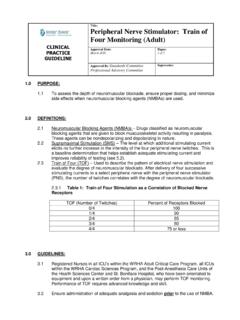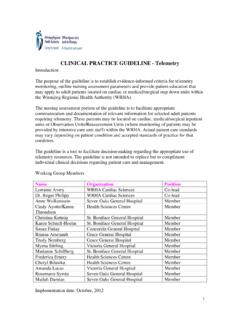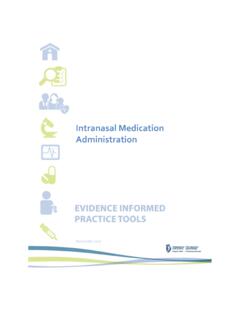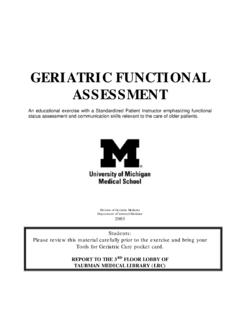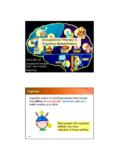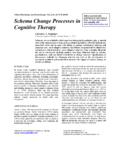Transcription of OCCUPATIONAL THERAPY COGNITIVE ASSESSMENT …
1 Vancouver Coastal Health and Providence Health Care, OCCUPATIONAL THERAPY Practice: OCCUPATIONAL THERAPY COGNITIVE ASSESSMENT Inventory & References, v. 2 (April 2014) page 1 of 35 OCCUPATIONAL THERAPY COGNITIVE ASSESSMENT INVENTORY v. 2: April 2014 update Purpose: This inventory was developed to complement the algorithm entitled An OT Approach to Evaluation of Cognition/Perception . This is an inventory of COGNITIVE (but not perceptual) ASSESSMENT tools identified by OTs within VCH and PHC. These tools are not meant to be used in isolation during the process of COGNITIVE ASSESSMENT but, instead, during Steps 4 & 5 of the ASSESSMENT process (as per the algorithm). Although this inventory provides a comprehensive list of standardized tools available to OTs to measure cognition, it is not an exhaustive list. **Note: a fairly comprehensive source of Perceptual Assessments (and many of the COGNITIVE Assessments) can be found on Strokengine ( ). Category of ASSESSMENT : adopted from An OT Approach to Evaluation of Statistical Evaluation Criteria: from StrokEngine (accessed Sept 2013), Cognition/Perception , Vancouver Coastal Health, April 2011 (revised March 2013) Reliability screening ASSESSMENT In-depth ASSESSMENT Internal consistency (Chronbach s or split-half statistics) Excellent Adequate Poor < Test-re-test or Inter-rater reliability (ICC or kappa statistics) Excellent Level of task performance (ICF.)
2 Activity & participation) Provides screening ASSESSMENT in context of occupation ( COGNITIVE Performance Test, Kettle Test) May provide higher ecological & predictive validity than impairment-based screening In-depth understanding of the impact of COGNITIVE deficits on occupation ( AMPS, EFPT, ILS) May provide higher ecological & predictive validity than in-depth ASSESSMENT at level of impairment Adequate Poor < Validity Concurrent and construct/convergent correlations Excellent Adequate Level of Impairment (ICF: body-structure) To augment screening at level of task performance ( SMMSE, MoCA, Cognistat) Be aware of limitations ( predictive validity, depth of ASSESSMENT ) To provide some in-depth understanding of specific COGNITIVE components such as memory, attention. ( Rivermead Behavioural Memory Test, Test of Everyday Attention) Poor DEFINITIONS: **In deciding whether or not an ASSESSMENT tool is precise, it is important to consider both reliability and validity.
3 Reliability: Does the test provide a consistent measure? Internal consistency = the extent to which the items of a test measure various aspects of a common characteristic ( , memory ). Do the items/subtests of the measure consistently measure the same aspect of cognition as each other? Test-retest reliability = the extent to which the measure consistently provides the same results when used a second time (re-test). Parallel-form reliability would involve 2 different/alternate versions of the same test. Inter-rater reliability = the extent to which two or more raters (assessors) obtain the same result when using the same instrument do they produce consistent results? Validity: Does the test measure what it is supposed to measure? Criterion validity = the extent to which a new measure is consistent with a gold standard criterion ( , a previously validated measure). For concurrent validity, the measures are administered at approximately the same time. For predictive validity, typically one measure is administered at some time prior to the criterion measure (to examine whether the measure can predict, or correlate with, the outcome of a subsequent criterion event).
4 Note: poor concurrent validity would suggest that the tests being compared measure different constructs; adequate concurrent validity suggests some shared variance in the constructs being measured; and excellent concurrent validity suggests that the tests measure very similar constructs. If 2 tests are highly correlated with each other, then one would want to question the need for having both tests you would then want to determine other ways in which one test might be more superior than the other (for example, one takes less time to administer). Construct validity = the extent to which a test can be shown to measure a construct, memory or cognition for everyday function . The construct validation process may be used when a gold standard (previously validated criterion) does not exist, thus, when one cannot test for concurrent validity. Convergent validity is the extent to which a test agrees with another test (or test) believed to be measuring the same attribute. Discriminant validity is the extent to which tests that are supposed to be unrelated are, in fact, unrelated ( , measure different things).
5 Group differences refers to: Does the measure allow you to differentiate between 2 or more populations? for example as determined by analyzing for statistically significant differences between the groups on the measure. Ecological validity refers to: Does the measure reflect behaviours/function that actually occur in natural/everyday settings? ASSESSMENT Name Overview Psychometrics Reliability & Validity Pros & Cons Vancouver Coastal Health and Providence Health Care, OCCUPATIONAL THERAPY Practice: OCCUPATIONAL THERAPY COGNITIVE ASSESSMENT Inventory & References, v. 2 (April 2014) page 2 of 35 AMPS: ASSESSMENT of Motor and Process Skills In-depth ASSESSMENT ; Task performance level Population: age > 2 years A standardized, performance-based, observational ASSESSMENT to measure the quality of a person s ability for ADL and IADL tasks by rating the effort, efficiency, safety and independence in chosen, familiar, and life-relevant ADL tasks. The assessor selects 2-3 tasks from a list of 87 tasks within 13 major groups (from very easy ADL tasks including eating a snack with a utensil, to much harder than average ADL tasks including making Spanish omelette with added ingredients).
6 Other tasks include raking grass, cleaning a bathroom, ironing a shirt, upper body grooming, shopping, etc.). Task is selected according to level of difficulty and meaning to person being assessed. Time to administer: varies with activity chosen Scoring: 16 motor and 20 process skill items are rated on a 4-point scale (from 1-deficit, to 4-competent), generating a Process score and a Motor score. Cut-off scores have been developed between needs assistance and independent . Once an OT has successfully calibrated as a reliable and valid AMPS evaluator, s/he is able to use a personal coy of the AMPS computer-scoring software to generate a Graphic Report and a Results and Interpretation Report. Minimal Clinical Difference (MCD): not determined to date. Reliability: A number of studies have been conducted showing excellent internal consistency, test-retest reliability and inter-rater reliability (Douglas et al., 2008). Some examples from the literature: Excellent test-retest reliability (elderly adults) The severity calibrations (using many faceted Rasch analyses ) were stable over time for of ratings for a group of 40 trained raters.
7 Predictive Validity: Excellent validity (for Process score) for predicting safety 2 weeks post-discharge home (acute psychiatry) Process score is stronger than Motor score in predicting need for level of assistance to live in the community, although new (2010) cut-off scores have only fair to good discrimination power using ROC analysis Group Differences: (no literature reviewed to date) Other Aspects of Validity: Many studies have been conducted and, overall, the AMPS correlates with at least 5 other measures and is predictive of ADL, level of care, and independence in the home (Douglas et al., 2008). Some examples of research findings: Adequate to excellent concurrent validity compared to tests of cognition & function FIM & MMSE (mild memory impairment or dementia) Poor concurrent validity in comparing AMPS Process score (measure of task) and the Large Allen COGNITIVE Level Test (measure of impairment) (stroke) Adequate concurrent validity between AMPS Process score and level of employment (schizophrenia) Pros: Provides for a standardized ADL analysis Identifies between difficulties with process ( COGNITIVE ) & motor (physical) tasks Some cultural sensitivity ( client plans own meal of choice) Useful in mental health & physical disability settings Easy to convert data to a written report (a program does this for you.)
8 Also provide graphics) Good for variety of age groups May be more appropriate than using the ASSESSMENT activities offered by other task/performance tests such as ILS Based on MOHO Is recommended for ASSESSMENT of executive functions in a published inventory of tests of executive function for stroke (Poulin et al, 2013) Cons: OT needs specific training to administer Expensive training: 5-day course (and must follow-up training by testing 10 people within 3 months and submitting results to become calibrated ). Not specifically designed to evaluate for presence of COGNITIVE impairments but Process score can represent COGNITIVE limitations Research recommends assessing client in home instead of clinic because environmental factors may influence performance in particular Process score (Park 1994) Limitations for use on its own to predict level of assistance or predict employment (see psychometrics) Behavioural ASSESSMENT of Dysexecutive Syndrome (BADS) (a version is also available for children: BADS-C.
9 However, no information is contained here about it) In-depth ASSESSMENT ; Impairment level. Population: adults with: -schizophrenia -brain injury -dementia/Alzheimer s disease (may not be so good for MCI-mild COGNITIVE impairment) The BADS aims to assess for everyday executive impairment . There are 6 subtests (rule shift cards, action program, key search, temporal judgment, zoo map, & modified 6 elements). The test kit also provides a questionnaire, the DEX (Dysexecutive Questionnaire), which is scored separately. Time to administer: approx. 40 minutes assuming OT is familiar with the test; plus extra time to score (including conversion from raw to profile to standardized scores). Scoring: For each BADS subtest, the raw scores are converted to profile scores (0-4), which are then summed to produce an overall total score (battery profile score, 0-24, which in turn gets converted to a standardized score with a mean of 100). The DEX is not included in the BADS total score; it is scored separately, by adding up the individual items.
10 Reliability: Excellent inter-rater reliability (r= for subtests) (adults with brain injury) Test-retest reliability is not expected to be high, considering that a critical aspect of the test is novelty. However, it has been found to range from poor to excellent (at 3 weeks) for a group of adults with schizophrenia, and poor to adequate (at 6 to 12 mos) for a group of adults with brain injury. Note: for both groups, participants tended to obtain higher scores on re-administration (may be a practice effect including that the test was not so novel the second time; or could possibly show improved function over time) adequate internal consistency ( = ) (schizophrenia) Predictive Validity: chronic schizophrenia: BADS found to be a predictor of IADLs (beyond outcomes accounted for by basic COGNITIVE skills Pros: Has been validated with a number of populations BADS demonstrates some ecological validity (in terms of predicting everyday function) for: (a) schizophrenia (b) traumatic brain injury, including more so than traditional neuropsych measures of executive function although the predictive validity is improved if multiple modes of ASSESSMENT are used ( BADS + neuropsych tests + observations) In addition to providing numerical scores, the BADS can provide useful qualitative (observational) information, in terms of the efficiency or effectiveness of strategies a person uses (or not) to complete subtests DEX appears to be a good measure of executive function if administered by a clinician (but not by the client or a relative) If time is limited, then the DEX (or similar questionnaire) is likely the best measure of ASSESSMENT Name Overview Psychometrics Reliability & Validity Pros & Cons Vancouver Coastal Health and Providence Health Care, OCCUPATIONAL THERAPY Practice: OCCUPATIONAL THERAPY COGNITIVE ASSESSMENT Inventory & References, v.)




